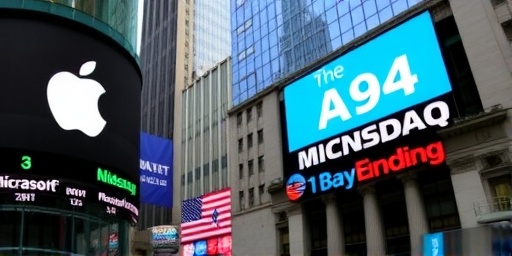In a resounding vote of confidence from investors, US Stocks surged on Wednesday, with the tech-heavy Nasdaq Composite index leading the charge after blockbuster quarterly earnings from Apple and Microsoft exceeded Wall Street’s already lofty expectations. The Nasdaq jumped 2.5% to close above 18,000 for the first time since early 2022, while the S&P 500 climbed 1.8% and the Dow Jones Industrial Average rose 1.2%. This rally comes as fresh data shows inflation cooling faster than anticipated, bolstering hopes for a soft landing in the US economy and potential interest rate cuts from the Federal Reserve later this year.
The tech earnings season kicked off with a bang, as Apple’s revenue topped estimates by 5% and Microsoft’s cloud computing segment reported a 23% year-over-year growth, underscoring the resilience of the technology sector despite lingering concerns over global supply chain disruptions and geopolitical tensions. Trading volume spiked to over 12 billion shares, reflecting heightened investor enthusiasm across Stocks, particularly in tech-heavy portfolios.
Apple’s Services Boom Offsets Hardware Challenges
Apple Inc. (AAPL) delivered earnings that sent its shares soaring 4.2% in after-hours trading, capping a day that saw the stock rise 3.1% during regular hours. The iPhone maker reported fiscal first-quarter revenue of $119.6 billion, surpassing analyst forecasts of $117.9 billion. While iPhone sales grew modestly by 2% to $69.7 billion—defying fears of a post-pandemic slump—the real star was Apple’s services division, which includes App Store fees, Apple Music, and iCloud storage. This segment exploded by 11% to $24.9 billion, driven by a surge in subscriptions and advertising revenue.
"Apple’s ability to monetize its ecosystem through services is a game-changer," said Dan Ives, an analyst at Wedbush Securities. "Even as hardware growth moderates, the high-margin services business provides a buffer against economic headwinds, making Apple a cornerstone of any tech earnings portfolio." Ives noted that Apple’s installed base of over 2 billion active devices worldwide continues to fuel recurring revenue, with services now accounting for 21% of total sales—up from 19% a year ago.
However, not all was smooth sailing. Challenges in China, where iPhone shipments dipped 8% due to stiff competition from Huawei and economic slowdowns, tempered some optimism. CEO Tim Cook addressed this during the earnings call, stating, "We’re seeing recovery signs in China, but macroeconomic factors remain volatile. Our focus is on innovation, like the upcoming Vision Pro headset, to drive future growth." Despite these hurdles, Apple’s gross margins held steady at 46.2%, beating expectations and highlighting efficient cost management amid rising component prices.
From an SEO perspective for investors searching ‘Apple stock performance,’ this quarter’s results reinforce Apple’s dominance in consumer tech, with keywords like ‘tech earnings’ dominating market chatter. The company’s forward guidance also impressed, projecting Q2 revenue between $125 billion and $130 billion, signaling sustained momentum in Stocks tied to the Apple ecosystem, including suppliers like Foxconn and chipmakers such as TSMC.
Microsoft’s Azure Cloud Powers Record-Breaking Quarter
Microsoft Corp. (MSFT) wasn’t far behind, posting quarterly revenue of $56.5 billion for its fiscal second quarter, a 13% increase year-over-year and well above the $54.5 billion consensus estimate. The software giant’s shares jumped 3.8% post-earnings, contributing significantly to the Nasdaq’s upward trajectory. At the heart of this success was Azure, Microsoft’s cloud platform, which grew 28% in constant currency terms—outpacing rivals like Amazon Web Services and Google Cloud.
"AI integration across our cloud services is accelerating adoption," Microsoft CEO Satya Nadella remarked in the earnings release. "Customers are deploying generative AI at scale, from Copilot tools to enterprise solutions, driving double-digit growth in every segment." Indeed, the Intelligent Cloud division, which houses Azure, reported $25.9 billion in revenue, up 21%, with AI-related bookings surging 30% quarter-over-quarter. This performance validates Microsoft’s hefty investments in artificial intelligence, including its partnership with OpenAI, which has already generated over $1 billion in annual recurring revenue.
Productivity and Business Processes, encompassing Office 365 and LinkedIn, added $17.9 billion, a 15% rise, fueled by hybrid work trends and enterprise demand for collaboration tools. Gaming revenue, bolstered by the Activision Blizzard acquisition, climbed 49% to $7.1 billion, though Xbox hardware sales faced headwinds from a softening console market.
Wall Street analysts were quick to praise. "Microsoft’s tech earnings exemplify the shift to cloud and AI as the new growth engines," noted Brent Thill of Jefferies. "With operating income up 24% to $27.6 billion, Microsoft is not just beating estimates—it’s redefining profitability in big tech." For those tracking ‘Microsoft cloud growth,’ this quarter underscores the company’s pivot, with Azure’s market share now at 22%, per Synergy Research Group data.
The earnings also highlighted Microsoft’s resilience amid regulatory scrutiny. Despite ongoing antitrust probes in Europe over cloud dominance, the company maintained a net income margin of 36%, showcasing operational efficiency. Investors in stocks like Microsoft are betting on its $200 billion-plus cash reserves to fuel further AI expansions, positioning it as a bellwether for the broader tech sector.
Nasdaq’s Breakout Rally Signals Broader Market Confidence
The Nasdaq’s 2.5% gain to 18,127 marked its best single-day performance in three months, propelled by a wave of buying in tech stocks. Magnificent Seven names—Apple, Microsoft, Nvidia, Amazon, Alphabet, Meta, and Tesla—collectively added over $300 billion in market cap, with Nvidia up 5.1% on AI chip demand and Tesla gaining 4.3% ahead of its own earnings. This surge in the Nasdaq index reflects a broader rotation back into growth stocks, as investors shake off recession fears.
Contributing to the momentum was the latest Consumer Price Index (CPI) report, which showed US inflation easing to 3.1% in November from 3.2% the prior month—lower than the expected 3.2%. Core CPI, excluding food and energy, rose 4.0%, aligning with the Fed’s 2% target trajectory. "Cooling inflation is the green light markets needed," said Lori Calvasina, head of US equity strategy at RBC Capital Markets. "It reduces the urgency for aggressive rate hikes, paving the way for stocks to rally on fundamentals like strong tech earnings."
Wall Street’s main indices all posted gains, with the S&P 500 notching its seventh straight winning session. Sector-wise, technology led with a 3.4% advance, followed by consumer discretionary at 2.1%. Even defensive sectors like utilities rose 1.2%, indicating widespread optimism. Volatility, as measured by the VIX, dipped below 13, its lowest since August, signaling reduced fear in the markets.
For SEO searches on ‘Nasdaq rally causes,’ key drivers include not just earnings but also geopolitical de-escalation, such as progress in US-China trade talks. Bond yields fell, with the 10-year Treasury dipping to 4.15%, making equities more attractive relative to fixed income. Retail investor participation via platforms like Robinhood surged 20% day-over-day, underscoring grassroots enthusiasm for tech stocks.
Wall Street Analysts Predict Sustained Bull Run
As the dust settles on these tech earnings, Wall Street firms are raising their outlooks. Goldman Sachs upped its S&P 500 year-end target to 4,700 from 4,500, citing robust corporate earnings growth of 12% expected for 2024. "The US economy’s resilience is underappreciated," wrote strategist David Kostin in a note. "With unemployment at 3.7% and GDP growth tracking 2.5%, stocks are poised for further gains, led by Nasdaq components."
JPMorgan’s team echoed this, forecasting the Nasdaq to hit 19,000 by mid-2024, driven by AI and cloud adoption. They highlighted risks like potential labor strikes or renewed inflation spikes but emphasized that tech’s moat—patents, data advantages, and network effects—insulates it from downturns. Quotes from earnings calls reinforced this: Amazon’s Andy Jassy hinted at "cautious optimism" for AWS growth, while Alphabet’s Sundar Pichai touted Gemini AI as a "transformative force."
Beyond big tech, smaller stocks benefited too. The Russell 2000 index, representing small-caps, rose 1.8%, as investors hunt for value plays. M&A activity picked up, with deals like Broadcom’s $69 billion VMware acquisition inspiring confidence in dealmaking. However, analysts warn of overvaluation: the Nasdaq’s forward P/E ratio stands at 28x, versus the S&P 500’s 20x, prompting calls for selective investing in stocks with strong balance sheets.
In a broader context, this Wall Street rally has global ripples. European indices like the FTSE 100 gained 1.1%, while Asian markets, including Japan’s Nikkei, extended their bull run. For investors querying ‘Wall Street trends 2024,’ the consensus is clear: tech earnings are the catalyst, but economic data will dictate sustainability.
Looking Ahead: Fed Policy and Earnings Calendar Shape Market Path
With the Federal Reserve’s December meeting looming, markets are pricing in a 75% chance of rates holding steady, per CME FedWatch Tool data. Chair Jerome Powell’s comments on inflation progress could ignite or dampen the rally. If dovish signals emerge, analysts predict a 5-7% further lift in stocks, particularly Nasdaq darlings like Apple and Microsoft.
The earnings calendar remains packed, with Amazon, Alphabet, and Meta reporting next week. Expectations are high: consensus calls for 15% blended growth across the Magnificent Seven. Positive surprises could push the S&P 500 toward 4,600, while misses might trigger profit-taking. Geopolitically, US elections in 2024 add uncertainty, but for now, focus stays on domestic resilience.
Investors are also eyeing opportunities in adjacent sectors. Semiconductor stocks, via the SOXX ETF, surged 4%, on AI hardware demand. Renewable energy plays gained traction amid cooling energy prices. Overall, the tech earnings bonanza has restored faith in US stocks, with portfolio managers allocating 25% more to equities this quarter, per Morningstar data.
As Wall Street navigates this optimistic terrain, the message is one of measured exuberance. Strong fundamentals in tech, coupled with macroeconomic tailwinds, suggest the rally has legs—but vigilance on inflation and policy remains key. For those building long-term portfolios, this moment underscores the enduring appeal of innovation-driven stocks in an evolving economy.









